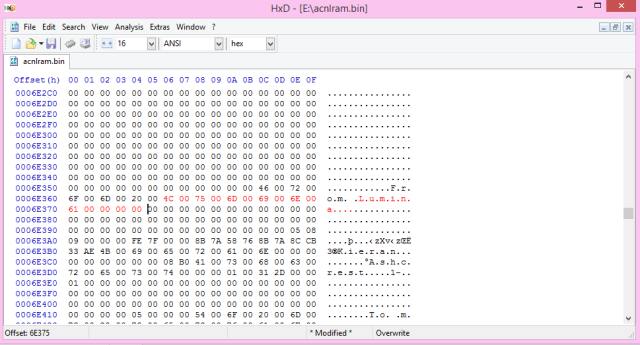

One of the load commands is responsible for decrypting the executable. The iPhone apps are normally encrypted and are decrypted by the iPhone loader at run time. This segment contains the tables of link edit information, such as the symbol table, string table, and so forth, used by the dynamic loader to link an executable file or Mach-O bundle to its dependent libraries. In user-level fully linked Mach-O files, the last segment is the link edit segment.

The exact number and layout of segments and sections is specified by the load commands and the file type.Ĥ. Each segment defines a region of virtual memory that the dynamic linker maps into the address space of the process.
#0xed hex editor code#
Each section of a segment contains code or data of some particular type. Each segment contains zero or more sections. The names of shared libraries that contain definitions for the main executable’s imported symbolsģ.ğollowing the load commands, all Mach-O files contain the data of one or more segments.The initial execution state of the main thread of the program.The location of the symbol table (used for dynamic linking).The initial layout of the file in virtual memory.Among other information, the load commands can specify:
#0xed hex editor series#
The header also contains other basic file type information, indicates the target architecture, and contains flags specifying options that affect the interpretation of the rest of the file.Ģ.ĝirectly following the header are a series of variable-size load commands that specify the layout and linkage characteristics of the file. The image below illustrates the file format at high-level:Ī Mach-O file contains three major regions:ġ.Ět the beginning of every Mach-O file is a header structure that identifies the file as a Mach-O file. The iPhone apps are based on Mach-O (Mach Object) file format. Some groundwork, taken from Apple’s API docs :
#0xed hex editor how to#
If you really want to know how, we insist you figure it out yourself and direct you to read through PKSM's code.This blog post steps through how to convert encrypted iPhone application bundles into plaintext application bundles that are easier to analyse.ġ) Jailbroken iPhone with OpenSSH, gdb plus other utilities ( etc. It is possible to unlock them (see screenshots below), but you will not be told how to unlock them. You may see this called different names at times, such as:īytes that are locked (greyed out) are like that for a reason: it is usually far more dangerous to edit them compared to unlocked bytes, especially if you don't know what values are legal for the particular byte. represents how many times the hex editor needs to be unlocked in order to edit the field's value.įor fields that span multiple bytes, be aware that Pokémon stores data in little-endian format. The table below lists all of the exclusive fields for each of the supported formats that you can edit.

In order to edit those you will need to go into the hex editor and find the appropriate byte(s). While PKSM's normal editor screens allow you to change many things about your Pokémon, there are some things that don't appear on them. The controls are pretty simple: navigation is done with the d-pad or circle pad and edits can be made with A (increase byte's value), X (decrease byte's value), or the touch screen. For those fields that don't show as a number in-game, you will also need to find some kind of reference for what values mean. You will need to be able to convert values between decimal and hexadecimal (you can easily find a tool to help with this online). There is a learning curve to using the hex editor. For bytes that are unlocked, there are also editing controls in the form of plus and minus buttons above and below the value of the byte and/or labeled boxes for toggling flags kept in that byte. The bottom screen shows the index of the currently selected byte, it's value, and sometimes a translation of the value into a more understandable version (like the Species bytes). If a byte is grayed out/disabled, you will need to unlock it before you can change it. The byte that is current selected has a box around it, and it's purpose is briefly described at the bottom of the screen. The top screen shows the Pokémon you're editing in raw hex. When you first open it, you'll be greeted by a screen that looks completely different from the other Editor screens you've seen so far. It can be accessed by tapping the block of purple letters in the upper-right corner when editing a Pokémon in the Editor. The Hex Editor is an incredibly powerful, and potentially intimidating, tool PKSM provides you for editing your Pokémon.


 0 kommentar(er)
0 kommentar(er)
